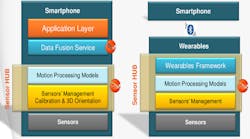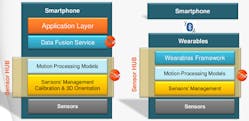Integrating sensor data into useful information is not just adding a bunch of numbers together or running a basic transform or correlation on some data. A sensor hub needs to handle a wide range of sensor information and be able to present that basic information as well as extrapolated information to an application that does not have to worry about how that information is obtained. That is what Movea's latest SASH (smart architecture sensor hub) evaluation kit does. It targets OEMs that will incorporate the context awareness technology (Fig. 1) into their products.
Related Articles
- Data Fusion Enables Next-Generation Smart Mobile Applications
- Sensor Fusion Or Sensor Confusion?
- Sensor Fusion For Play And Profit
- Ref Design Creates 3D Remotes
Using less than 4 mW, the system can provide pedestrian level dead reckoning. The ability to provide pedestrian navigation without the need for GPS is very useful especially in conditions where GPS is unavailable such as underground or in many buildings. After 15 minutes of operation it still has a distance deviation under 5% and 2% for orientation. It can determine floor changes with a 99.7% accuracy. The system is designed for integration with WiFi and Bluetooth positioning via triangulation as well as map matching when a map is available.
The system also provides step cadency in addition to direction and distance information. The system can consume less than 1 mW by scaling down the processing and functionality. Still, it can provide information such as context awareness such as whether a person is in a car, train, plane or even an elevator. Of course, it can tell whether the person is walking, running or resting as well.
The sensor hub can live in the smartphone or in a wearable using wireless communication support such as Bluetooth (Fig. 3). This can reduce the communication overhead since the host is not handling the sensor integration. Low power operation is also critical for wearables where power scavenging may be used or where limited battery capacity is available.
The evaluation kit includes the Movea Studio development tool chain. This provides debug, calibration and qualification support.



